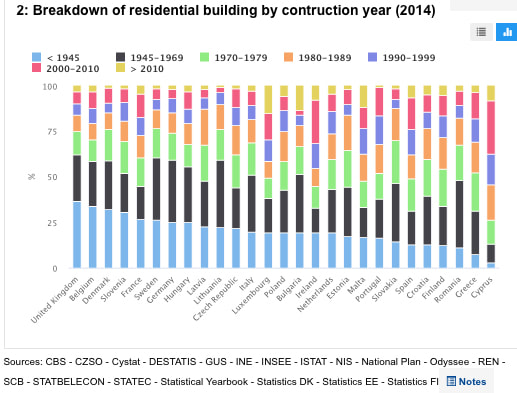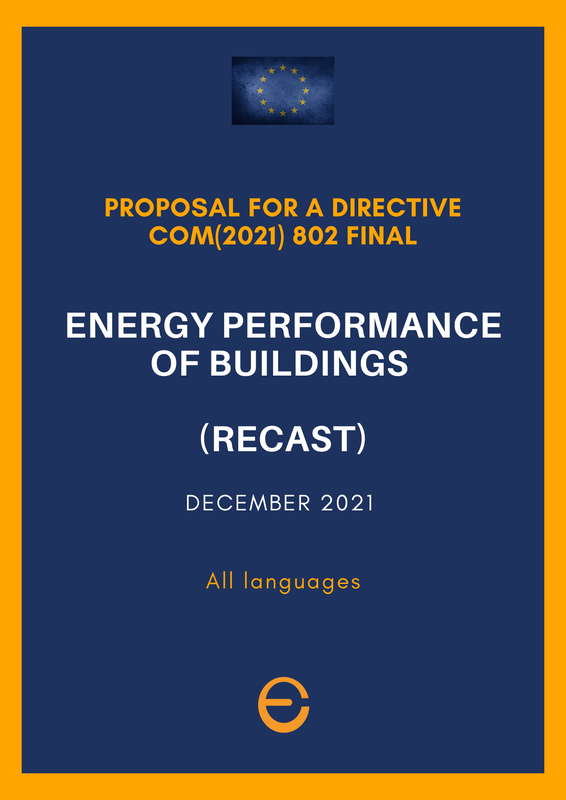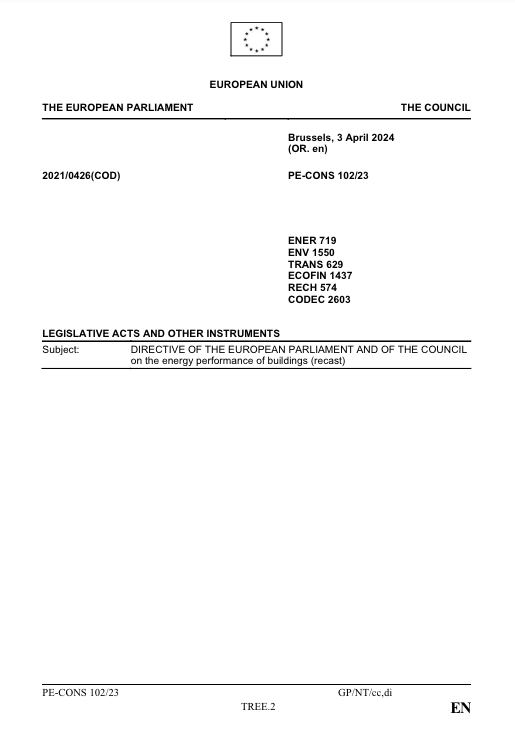|
Brussels, |
|
Directive on Energy performance of buildings (EPBD)
To increase the energy performance of buildings, the EU has established a legislative framework with two EU Directives. One is dealing with Energy Efficiency in Europe, one more specific on Energy performace of the Buildings. The EU goal is to help member States to achieve an energy efficient and decarbonised building stock by 2050, to encourage investments and help consumers and businesses make more informed choices to save energy and money. On December 2022, the European Parliament adopted the Commission's proposal for amending the Directive 2010/31/EU, which has to be confirmed by EU Council. The amendment concerns the solar energy for buildings. In parallel, on 25 July 2023, the Council of the EU confirmed the agreement with the European Parliament on the new Directive on Energy Savings. On 12 March 2024, the European Parliament adopted its position on the new Directive on energy saving in buildings.
The Two Directives
Outline show/hide
ENERGY PERFORMANCE OF BUILDING DIRECTIVE
THE LEGISLATIVE FRAMEWORK
Directive 2010/31/EU
Energy Performance of Buildings
-
AMENDED IN 2018 BY:
Directive 2018/844/EU, on the energy performance of buildings
-
PARTIAL REPEALED ART.2 IN 2023 BY:
Directive (EU) 2023/1791, on energy efficiency
(and amending Regulation (EU) 2023/955 (recast))
-
-
Proposal for a Directive COM(2021) 802, to recast the Directive
- EU Council and European Parliament reached an agreement on a revised version in December 2023. Adoption before the end of 2024. Read
- Waiting for new Directive
- EU Council and European Parliament reached an agreement on a revised version in December 2023. Adoption before the end of 2024. Read
Directive 2012/27/EU
Energy Efficiency
-
ART. 4 AMENDED IN 2018 BY:
on the energy performance of buildings
-
RECAST IN 2023 BY:
Directive (EU) 2023/1791, on energy efficiency
(and amending Regulation (EU) 2023/955 (recast))
-
The two Directives:
- Directive 2010/31/EU on the energy performance of buildings (EPBD) (amended in 2018, 2023 and 2024. EP voted the compromise text on 12 March 2024 and EU Council confirmed the adoption on 12 April 2024.
- Directive 2012/27/EU on energy efficiency (Replaced by a recast Directive in 2023).
Together, the two directives promote policies for:
- increasing the energy efficient and decarbonised building stock by 2050
- creating a stable environment for investment decisions
- enabling consumers and businesses to make more informed choices to save energy and money
Goals of the Directive on Energy Performance Building (EPBD)
- It aims to improve the energy performance of buildings in the EU
- It sets out minimum requirements and a common framework for calculating energy performance.
- It was amended in 2018 and 2023 and a new proposal for a recast was negotiated by EU Institution in December 2023
Measures to improve the building stock
The EPBD covers a broad range of policies and supportive measures that will help national EU governments boost energy performance of buildings and improve the existing building stock.
For example:
In addition to these requirements, under the Energy Efficiency Directive (2012/27/EU), EU countries must make energy efficient renovations to at least 3% of the total floor area of buildings owned and occupied by central governments. National governments are recommended to only purchase buildings that are highly energy efficient.
The Commission has also published a series of recommendations on the building renovation (EU)2019/786 and building modernisation (EU)2019/1019 aspects of the new rules.
The EPBD covers a broad range of policies and supportive measures that will help national EU governments boost energy performance of buildings and improve the existing building stock.
For example:
- EU countries must establish a long-term renovation strategies, aiming at decarbonising the national building stocks by 2050, with indicative milestones for 2030, 2040 and 2050. The strategies should contribute to achieving the national energy and climate plans (NECPs) energy efficiency targets
- EU countries must set cost-optimal minimum energy performance requirements for new buildings, for existing buildings undergoing major renovation, and for the replacement or retrofit of building elements like heating and cooling systems, roofs and walls
- all new buildings must be zero-energy buildings (NZEB) from 31 December 2020. Since 31 December 2018, all new public buildings already need to be NZEB
- energy performance certificates must be issued when a building is sold or rented, and inspection schemes for heating and air conditioning systems must be established
- electro-mobility is supported by introducing minimum requirements for car parks over a certain size and other minimum infrastructure for smaller buildings
- an optional European scheme for rating the ‘smart readiness’ of buildings is introduced
- smart technologies are promoted, including through requirements on the installation of building automation and control systems, and on devices that regulate temperature at room level
- health and well-being of building users is addressed, for instance through the consideration of air quality and ventilation
- EU countries must draw up lists of national financial measures to improve the energy efficiency of buildings
In addition to these requirements, under the Energy Efficiency Directive (2012/27/EU), EU countries must make energy efficient renovations to at least 3% of the total floor area of buildings owned and occupied by central governments. National governments are recommended to only purchase buildings that are highly energy efficient.
The Commission has also published a series of recommendations on the building renovation (EU)2019/786 and building modernisation (EU)2019/1019 aspects of the new rules.
|
Energy performance of buildings standards
The Commission has established a set of standards and accompanying technical reports to support the EPBD called the energy performance of buildings standards (EPB standards). These are managed by the European Committee for Standardisation (CEN). EU Buildings Factsheets The factsheets presents the most important features, including indicators and recommendations, in relation to implementation of EU buildings legislation. They also present key statistics, analysis and policy context. The country-specific factsheets also provide a national policy context. |
Recast of the Directives 2018/844/EU
|
In December 2021, the Commission proposed a recast of the directive. It upgrades the existing regulatory framework to reflect higher ambitions and more pressing needs in climate and social action, while providing EU countries with the flexibility needed to take into account the differences in the building stock across Europe.
It also sets out how Europe can achieve a zero-emission and fully decarbonised building stock by 2050. The proposed measures will increase the rate of renovation, particularly for the worst-performing buildings in each country. The revised directive will modernise the building stock, making it more resilient and accessible. It will also support better air quality, the digitalisation of energy systems for buildings and the roll-out of infrastructure for sustainable mobility. Crucially, the revised directive facilitates more targeted financing to investments in the building sector, complementing other EU instruments supporting vulnerable consumers and fighting energy poverty. In order to make sure that buildings are fit for the enhanced climate ambition, as presented in the 2030 Climate Target Plan and reflected in the “Delivering the European Green Deal Package” in July 2021, the Commission’s new proposal aims to contribute to reaching the target of at least -60% emission reductions by 2030 in the building sector in comparison to 2015 and achieve climate neutrality by 2050. |
|
It will work hand in hand with other initiatives of the European Green Deal package, in particular with the review of the proposed new emissions trading system for fuels used in buildings, the Energy Efficiency Directive, the Renewable Energy Directive, as well as the Alternative Fuels Infrastructure Regulation.
The main measures in the new proposal are:
The proposed revision of the directive has been discussed by the Council on 17 January 2023 and the European Paliament adopted the proposal on 14 March 2023. On 12 April 2024, the Council formally adopted the revised directive. |
The new EU rules for the buildings
1. Emissions
Currently, buildings account for over one third of greenhouse gas emissions in the EU. Under the new rules, by 2030 all new buildings should be zero-emission buildings, and by 2050 the EU’s building stock should be transformed into zero-emission building stock.
Currently, buildings account for over one third of greenhouse gas emissions in the EU. Under the new rules, by 2030 all new buildings should be zero-emission buildings, and by 2050 the EU’s building stock should be transformed into zero-emission building stock.
2. Energy performance
For non-residential buildings, the revised directive introduces minimum energy performance standards ensuring that such buildings do not exceed the specified maximum amount of primary or final energy that they can use per m2 annually. According to the new rules, in 2030 all non-residential buildings will be above the 16% worst performing buildings and by 2033 above the 26% worst performing buildings in terms of energy performance. This will lead to a gradual phase-out of the worst performing non-residential buildings. Member states can choose to exempt specific buildings from the rules, such as historical buildings, places of worship or buildings owned by the armed forces.
For non-residential buildings, the revised directive introduces minimum energy performance standards ensuring that such buildings do not exceed the specified maximum amount of primary or final energy that they can use per m2 annually. According to the new rules, in 2030 all non-residential buildings will be above the 16% worst performing buildings and by 2033 above the 26% worst performing buildings in terms of energy performance. This will lead to a gradual phase-out of the worst performing non-residential buildings. Member states can choose to exempt specific buildings from the rules, such as historical buildings, places of worship or buildings owned by the armed forces.
3. Energy use of residential buildings
Member states will also make sure that the average primary energy use of residential buildings will be reduced by 16% in 2030 and by 20-22% in 2035. At least 55% of the energy reduction will be achieved through renovation of the 43% worst performing residential buildings.
In their renovation efforts, member states will put in place technical assistance and financial support measures, with a focus on vulnerable households.
Member states will also make sure that the average primary energy use of residential buildings will be reduced by 16% in 2030 and by 20-22% in 2035. At least 55% of the energy reduction will be achieved through renovation of the 43% worst performing residential buildings.
In their renovation efforts, member states will put in place technical assistance and financial support measures, with a focus on vulnerable households.
4. Use of fossil fuels in buildings
In order to decarbonise the building sector, national building renovation plans will include a roadmap with a view to phase out fossil fuel boilers by 2040.
In order to decarbonise the building sector, national building renovation plans will include a roadmap with a view to phase out fossil fuel boilers by 2040.
5. Solar energy and sustainablemobility
The new rules will ensure the deployment of suitable solar energy installations in new buildings, public buildings and existing non-residential ones under renovation that requires a permit.
They will also provide for sustainable mobility infrastructure, including recharging points for electric cars in or next to buildings, pre-cabling or ducting to accommodate future infrastructure and parking spaces for bicycles.
The new rules will ensure the deployment of suitable solar energy installations in new buildings, public buildings and existing non-residential ones under renovation that requires a permit.
They will also provide for sustainable mobility infrastructure, including recharging points for electric cars in or next to buildings, pre-cabling or ducting to accommodate future infrastructure and parking spaces for bicycles.
Why buildings are important for reducing energy consumption?
Buildings are responsible for approximately 40% of EU energy consumption and 36% of the greenhouse gas emissions.
Buildings are therefore the single largest energy consumer in Europe.
At present, about 35% of the EU's buildings are over 50 years old and almost 75% of the building stock is energy inefficient. At the same time, only about 1% of the building stock is renovated each year.
Renovation of existing buildings can lead to significant energy savings, as it could reduce the EU’s total energy consumption by 5-6% and lower CO2 emissions by about 5%.
Investments in energy efficiency stimulates the economy, especially the construction industry, which generates about 9% of Europe’s GDP and directly accounts for 18 million direct jobs. SMEs in particular, benefit from a boosted renovation market, as they contribute more than 70% of the value-added in EU’s building sector.
Source: European Union, http://www.europa.eu/, 1998-2024
|
Brussels - Milano - Nice - Tokyo
|
eEuropa Belgium
Avenue Louise, 367 1050 Brussels BELGIUM Bld. Franck Pilatte, 19 bis
06300 Nice FRANCE YONO HOUSE 9-1 KAMIOCHIAI, SAITAMA-SHI, SAITAMA-KEN 〒 338-0001 JAPAN Via S. Veniero 6 20148 Milano ITALY |
All rights reserved - © Copyright eEuropa Belgium 2020-2024




